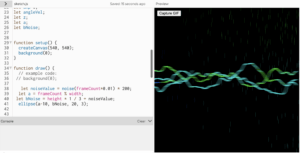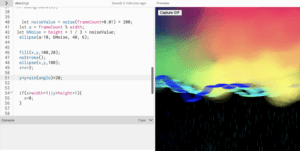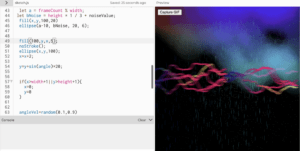Project Title: generative art
Link to my project:
https://editor.p5js.org/sf3972/sketches/cpOqYSbW3
Brief Description and Concept:
Generative art is a process of algorithmically generating new ideas, forms, shapes, colors, or patterns. The actor and film producer Jason Bailey once said that “your appreciation of this genre will only improve if you explore the algorithms and programming behind the work”. For my project this time, I comprehensively applied functions like oscillation motion, angular motion, Perlin noise, and so on to the canvas, generating a work where you can see speckled raindrop-like threadlets and dots scattered in a random way in the background. In the front are scarlet strings created by noise wining and tangled with each other and clouds of cold colors floating above.
Demo/Visual Documentation:
Coding:



Reflection/Lessons Learned:
List math functions that you utilized in your animation. Please share your experience while using them. What functions did you find useful? What made you confused and struggle?
Noise; Oscillation; Angular motion
I figured that noise is a great function to create generative art as the effect created with noise seems more natural and less artificial and patterned. But the noise that I used in my animation is a very basic one, so I would like to explore the function more in future projects. What confused me when I was doing my project was that if I inserted angle into two different functions, then when I changed the value of one, the other would change too. So I wondered how variables like angle can stay separated in different functions.
What kind of motion have you explored? What was the process like while combining them?
I combined angular and oscillation motion in my projects. When I was simply using the oscillation motion, the effect was sort of too patterned and didn’t change too much each time. But when I decided to insert an angle, like sin(angle*freq)*amp, the effect looked much better than before.
How did you adjust sin() values using map() function? Describe the effectiveness.
The use of map() effectively widened the range of sin() so that the values became more variable, adding a few highlights to the canvas.
How can circular (angular) movement be generated using sine and cosine?
As I mentioned above, angular movement makes the sin() and cos() look more natural by rotating and extending the shape at the same time so that the audience wouldn’t feel predictable and tedious in the middle of the animation.

this looks really nice Chanel!
and your documentation post are really complete. Great job!
Thank you!!